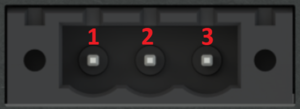TSF010 Powering Options: Difference between revisions
(Created page with "{{Template: networking_tsfxxx_manual_powering_options | name = TSF010 | series = TSF | poe = 0 | passive_poe = 0 | file_lan1 = Networking_tsf010_manual_p...") |
m (Vainius.l moved page Draft:TSF010 Powering Options to TSF010 Powering Options without leaving a redirect) |
||
| (One intermediate revision by the same user not shown) | |||
| Line 2: | Line 2: | ||
| name = TSF010 | | name = TSF010 | ||
| series = TSF | | series = TSF | ||
| passive_poe = 0 | | passive_poe = 0 | ||
}} | }} | ||
Latest revision as of 08:21, 8 May 2024
Main Page > TSF Switches > TSF010 > TSF010 Manual > TSF010 Powering OptionsThis chapter contains information on powering options supported by TSF010 switch.
Power socket
The switch has a 3-pin industrial DC power socket and can be powered by a 7-57 VDC power supply unit (PSU). Refer to the image below for the power socket's pinout information:
|
 |
|||||||||||||||
If you decide not to use the standard 9 VDC power supply unit and want to power the device with other voltages (7-57 VDC), please make sure that you choose a power supply of high quality. Some power supplies can produce voltage peaks significantly higher than the declared output voltage, especially during connection and disconnection.
While the device is designed to accept input voltage of up to 57 VDC peaks, high voltage power supplies can harm the device. If you want to use high voltage power supplies it is recommended to also use additional safety equipment to suppress voltage peaks from the power supply.
Ground loops
Do not connect the power supply negative terminal of our device to the chassis or earth exclusively.
This connection could cause ground loops. For example, if the antenna shield and power supply negative terminal are connected to the chassis or earth, it forms a ground loop, therefore unwanted current could flow through a device PCB ground and may cause damage.
In networking switches connecting our device power supply negative terminal to the chassis or earth could cause damage to other devices connected to the switch or unintentional power up of other devices.

